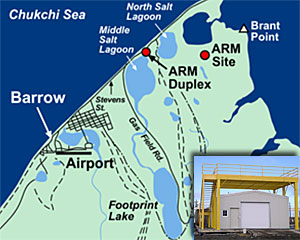Following four weeks of data acquisition, the Arctic Winter Water Vapor Intensive Operational Period (IOP) at the ARM Climate Research Facility’s North Slope of Alaska (NSA) locale was completed the weekend of April 9, 2004. In collaboration with the National Oceanic and Atmospheric Administration’s Environmental Technology Laboratory (ETL), the major goal of this IOP was to demonstrate that millimeter wavelength radiometers can substantially improve water vapor observations during arctic winters at the NSA and other high latitude research sites. Supplemental goals included forward modeling studies over a broad frequency range, demonstration of recently-developed calibration techniques, and application of infrared cloud imaging techniques. In addition, because the surface conditions at NSA in March are similar to those that are found at high altitudes at lower latitudes, the effort was particularly useful for studying parts of the thermal infrared spectrum that are normally opaque at the other ARM Climate Research Facility sites.

During the IOP, both the ARM MicroWave Radiometer and MicroWave Radiometer Profiler, as well as ETL’s Ground-based Scanning Radiometer, yielded excellent data over a range of conditions. Angular scanned and calibrated radiometer data ranging from 22 to 380 GHz were taken. Precipitable water vapor varied more than an order of magnitude from 1 to 10 mm, and surface temperatures varied from -10 to -40 C. Data plots from the cloud radar and the depolarization micropulse lidar indicate that clearly identifiable conditions of clear, liquid, mid-level ice, and mixed phase clouds were present during the IOP. High quality thermal images of the atmosphere were also taken throughout the IOP.
Vaisala RS90 radiosondes were launched four times a day from the new mezzanine adjacent to the ARM duplex in Barrow, Alaska, and once daily from ARM’s nearby instrumentation site. In addition, 10 dual radiosonde launches (RS90 plus chilled mirror) were sent up from the mezzanine. Afternoon and early morning launches were timed to be simultaneous with National Weather Service launches about 8 km away. In all, more than 120 radiosondes were launched in connection with this IOP.

